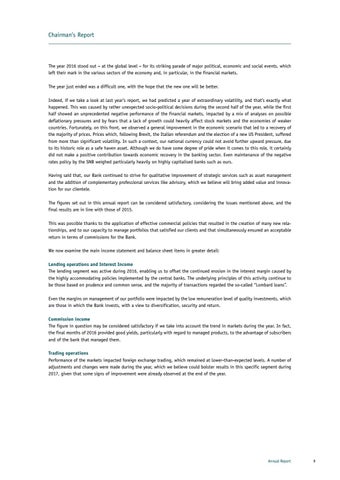Chairman’s Report
The year 2016 stood out – at the global level – for its striking parade of major political, economic and social events, which left their mark in the various sectors of the economy and, in particular, in the financial markets. The year just ended was a difficult one, with the hope that the new one will be better. Indeed, if we take a look at last year’s report, we had predicted a year of extraordinary volatility, and that’s exactly what happened. This was caused by rather unexpected socio-political decisions during the second half of the year, while the first half showed an unprecedented negative performance of the financial markets, impacted by a mix of analyses on possible deflationary pressures and by fears that a lack of growth could heavily affect stock markets and the economies of weaker countries. Fortunately, on this front, we observed a general improvement in the economic scenario that led to a recovery of the majority of prices. Prices which, following Brexit, the Italian referendum and the election of a new US President, suffered from more than significant volatility. In such a context, our national currency could not avoid further upward pressure, due to its historic role as a safe haven asset. Although we do have some degree of pride when it comes to this role, it certainly did not make a positive contribution towards economic recovery in the banking sector. Even maintenance of the negative rates policy by the SNB weighed particularly heavily on highly capitalised banks such as ours. Having said that, our Bank continued to strive for qualitative improvement of strategic services such as asset management and the addition of complementary professional services like advisory, which we believe will bring added value and innovation for our clientele. The figures set out in this annual report can be considered satisfactory, considering the issues mentioned above, and the final results are in line with those of 2015. This was possible thanks to the application of effective commercial policies that resulted in the creation of many new relationships, and to our capacity to manage portfolios that satisfied our clients and that simultaneously ensured an acceptable return in terms of commissions for the Bank. We now examine the main income statement and balance sheet items in greater detail: Lending operations and Interest Income The lending segment was active during 2016, enabling us to offset the continued erosion in the interest margin caused by the highly accommodating policies implemented by the central banks. The underlying principles of this activity continue to be those based on prudence and common sense, and the majority of transactions regarded the so-called “Lombard loans”. Even the margins on management of our portfolio were impacted by the low remuneration level of quality investments, which are those in which the Bank invests, with a view to diversification, security and return. Commission income The figure in question may be considered satisfactory if we take into account the trend in markets during the year. In fact, the final months of 2016 provided good yields, particularly with regard to managed products, to the advantage of subscribers and of the bank that managed them. Trading operations Performance of the markets impacted foreign exchange trading, which remained at lower-than-expected levels. A number of adjustments and changes were made during the year, which we believe could bolster results in this specific segment during 2017, given that some signs of improvement were already observed at the end of the year.
Annual Report 9






